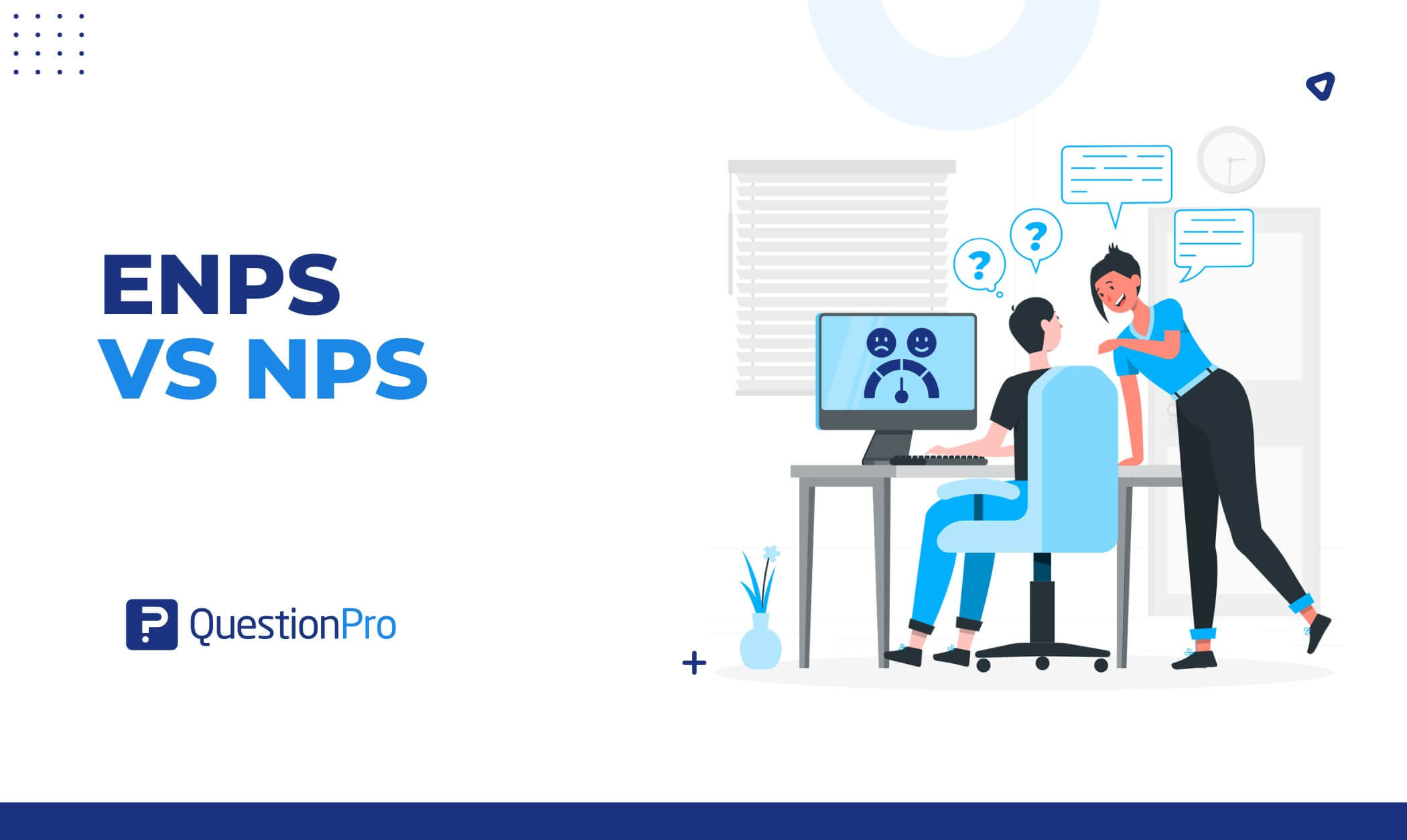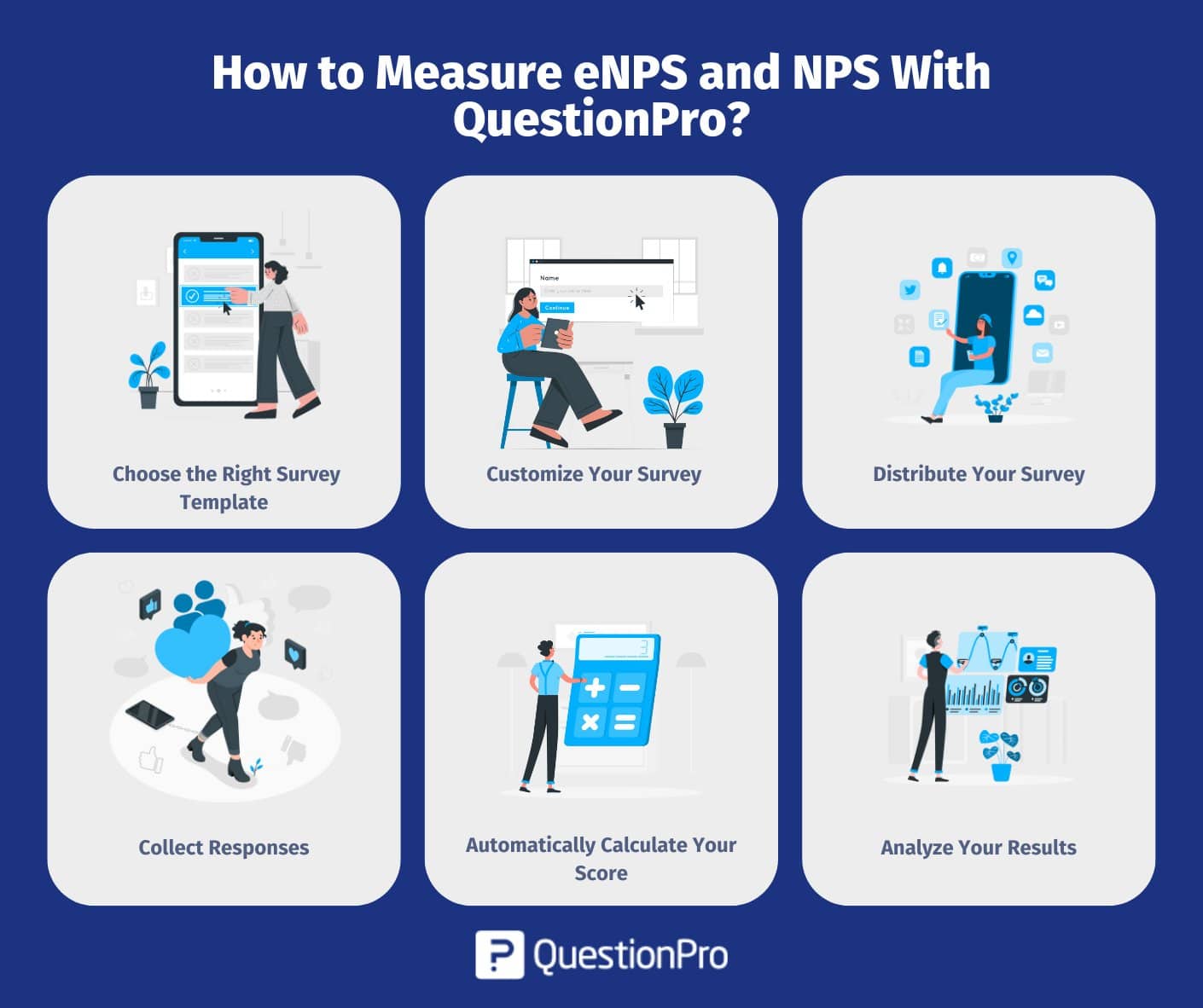
When it comes to growing a successful business, listening to feedback is key. But feedback doesn’t just come from customers, it also comes from your employees. This is something, eNPS vs NPS, that we will discuss in this blog.
You might have heard of Net Promoter Score (NPS), which measures customer satisfaction. But there’s also Employee Net Promoter Score (eNPS), which helps you understand how happy your team is at work.
In this blog, we’ll break down what NPS and eNPS are, how they’re different, when to use each one, and how tools like QuestionPro can help you measure both.
What is NPS?
NPS stands for Net Promoter Score. It’s a popular way for businesses to find out how happy their customers are and whether they’d recommend the brand to others.
The main question asked in an NPS survey is:
“On a scale of 0 to 10, how likely are you to recommend our product or service to a friend or colleague?”
Based on the answers, customers are divided into three groups:
- Promoters (9–10): These are your biggest fans. They’re happy with your service and are likely to spread the word.
- Passives (7–8): These customers are satisfied but not enthusiastic. They could easily switch to a competitor.
- Detractors (0–6): These are unhappy customers. They might complain or leave negative reviews.
To calculate your NPS score, subtract the percentage of Detractors from the percentage of Promoters. The final score can be anywhere between -100 and +100.
A high NPS means more people love your business and are willing to recommend it. It’s a quick and powerful way to measure customer loyalty and spot areas that need improvement.
What is eNPS?
eNPS stands for Employee Net Promoter Score. It’s a simple way for companies to measure how happy and loyal their employees are.
Just like businesses ask customers, with eNPS, they ask employees a similar question:
“How likely are you to recommend this company as a place to work?”
Employees answer on a scale of 0 to 10. Based on their responses, they’re grouped into three categories as to NPS:
- These employees are happy and likely to recommend the company, and they are called Promoters.
- They’re neutral, not unhappy, but not fully satisfied either, and they are called Passive.
- These employees are unhappy and wouldn’t recommend the company, and are known as Detractors.
The eNPS score is then calculated by subtracting the percentage of Detractors from the percentage of Promoters. The result can range from -100 to +100.
A higher eNPS means employees are more satisfied and engaged, which is great for the company’s culture and success.
eNPS helps businesses understand how their employees really feel and what they can do to make work a better place.
eNPS vs NPS: Key Differences
At first glance, eNPS and NPS might seem like the same thing—they both ask how likely someone is to recommend your company. But the key difference lies in who you’re asking and why.
Let’s break it down in an easy way:
| Key Facts | NPS (Net Promoter Score) | eNPS (Employee Net Promoter Score) |
| Who You Asking | NPS is for customers. It tells you how happy your customers are with your product or service. | eNPS is for employees. It shows how satisfied and loyal your employees feel toward the company. |
| The Main Question | NPS asks: “How likely are you to recommend our product or service to others?” | eNPS asks: “How likely are you to recommend this company as a place to work?” |
| The Purpose | NPS shows whether people love your product and if they’re likely to come back or refer others. | eNPS helps you spot if your team is engaged, motivated, or thinking about leaving. |
| Impact Areas | NPS helps improve things like customer service, product quality, and overall brand loyalty. | eNPS gives insights into workplace culture, leadership, communication, and job satisfaction. |
| How the Data Is Used | Use NPS results to boost customer satisfaction, build loyalty programs, or fix problem areas in your customer journey. | Use eNPS results to improve internal policies, employee engagement strategies, and company culture. |
Both are valuable, but they shine in different areas. Together, they give you a full picture of how people truly feel about your business inside and out.
When to Use eNPS?
You should use eNPS (Employee Net Promoter Score) when you want to understand how your employees truly feel about working at your company. It’s a quick and effective way to check the emotional temperature of your workplace.
Use eNPS when you want to:
- Check in on employee morale or satisfaction.
- Understand what’s working and what’s not in your company culture.
- Reduce employee turnover by spotting issues early.
- Create a better, more engaging workplace.
It’s especially useful during major changes, like leadership shifts, new policies, or after employee engagement initiatives.
When to Use NPS?
You should use NPS (Net Promoter Score) when you want to measure how satisfied and loyal your customers are—and whether they’re likely to recommend your business to others.
Use NPS when your goal is to:
- Understand how customers feel about your product or service.
- Identify your biggest supporters and potential brand advocates.
- Pinpoint areas in the customer journey that need improvement.
- Boost customer retention and overall satisfaction.
NPS is ideal to run after key customer interactions like a purchase, support call, or service delivery.
How to Measure eNPS and NPS with QuestionPro?
Measuring eNPS (Employee Net Promoter Score) and NPS (Net Promoter Score) with QuestionPro is straightforward and can be done in a few simple steps. Whether you’re looking to understand your customers’ satisfaction or employee engagement, QuestionPro helps you collect feedback and calculate the scores with ease.
Here’s how you can do it:

1. Choose the Right Survey Template
QuestionPro offers pre-built templates for both NPS and eNPS. These templates are ready to go, so you don’t have to worry about setting up questions from scratch. All you need to do is select the one that fits your needs—either customer-based (NPS) or employee-based (eNPS).
- NPS Survey: Asks customers, “How likely are you to recommend our product/service to a friend or colleague?”
- eNPS Survey: Asks employees, “How likely are you to recommend this company as a place to work?” in your employee satisfaction surveys.
2. Customize Your Survey (Optional)
If you want to change the questions or add some custom ones, you can easily do that in QuestionPro’s survey editor. You can also customize the look and feel of the survey to match your company’s branding.
3. Distribute Your Survey
Once your survey is ready, it’s time to send it out. QuestionPro offers multiple ways to distribute your survey, including:
- Email invitations
- Website pop-ups
- Social media links
- SMS links
Choose the method that works best for your audience. You can also schedule the survey to be sent out at a specific time for maximum engagement.
4. Collect Responses
Now that your survey is live, you can start gathering responses. QuestionPro automatically organizes responses into three categories for both NPS and eNPS:
- Promoters (9–10): These are your happiest and most loyal customers/employees.
- Passives (7–8): These people are satisfied but not passionate.
- Detractors (0–6): These are the people who are unhappy and may negatively influence others.
5. Automatically Calculate Your Score
The benefit of using QuestionPro is that the system automatically calculates your NPS or eNPS score based on the responses. It subtracts the percentage of Detractors from the percentage of Promoters to give you the final score.
Also, you can check out our calculators to calculate eNPS and NPS.
6. Analyze Your Results
QuestionPro provides easy-to-read visual reports and charts, so you can quickly understand the overall sentiment. You’ll see trends, the distribution of responses, and even specific comments from your customers or employees.
You can use these insights to improve customer experiences or enhance your employee engagement strategies.
Conclusion
We have learned that while NPS and eNPS might sound similar, they serve very different purposes. NPS helps you understand how satisfied your customers are and how likely they are to recommend your product or service. On the other hand, eNPS gives you insights into how employees feel about working at your company.
We explored their key differences, such as who the survey targets, the questions asked, and how the results are used. Knowing when to use each is essential for building a successful, people-centered organization.
We also saw how tools like QuestionPro make it easy to measure both NPS and eNPS with ready-made templates, automatic score calculations, and clear reports. With the right data at your fingertips, you can take meaningful steps to boost loyalty, both from customers and your team.
Using NPS and eNPS together gives you a 360-degree view of your business health from the outside in and the inside out. Contact the QuestionPro team for any kind of query and details!
Frequently Asked Questions (FAQs)
Answer: NPS measures customer loyalty, while eNPS measures employee satisfaction and engagement.
Answer: Yes, using both gives you insights into customer and employee experiences, helping improve overall business performance.
Answer: Yes, platforms like QuestionPro allow you to measure both easily with ready-made templates and automated scoring.
Answer: NPS asks customers: “On a scale of 0 to 10, how likely are you to recommend our product or service to a friend or colleague?”
Answer: The eNPS question asks employees: “On a scale of 0 to 10, how likely are you to recommend this company as a workplace to someone?”







